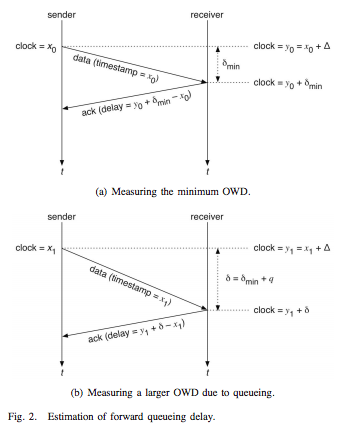Less than best effort : congestion control schemes do not always try to optimize goodput
The TCP congestion control scheme aims at providing a fair distribution of the network resources among the competing hosts while still achieving the highest possible throughput for all sources. In some sense, TCP’s congestion control scheme considers that all sources are equal and should obtain the same fraction of the available resources. In practice, this is not completely true since it is known that TCP is unfair and favors sources with a low round-trip-time compare to sources with a high round-trip-time. Furthermore, TCP’s congestion control scheme operates by filling the available buffers in the routers. This mode of operation results in an increase in the end-to-end delay perceived by the applications. This increased delay can be penalizing for interactive applications.
However, TCP’s congestion control RFC 5681 is only one possible design point in the space of congestion control schemes. Some congestion control schemes start from a different assumption than TCP. The Low Extra Delay Background Transport (LEDBAT) IETF working group is exploring such an alternate design point. Instead of assuming that all sources are equal, LEDBAT assumes that some sources are background sources that should benefit from the available network resources within creating unnecessary delays that would affect the other sources. The LEDBAT congestion control scheme is an example of a delay based congestion controller. LEDBAT operates by estimating the one-way delay between the source and the destination. This delay is estimated by measuring the minimum delay and assuming that this minimum delay can serve as a reference to evaluate the one-way delay. The figure below (from [RW12]) illustrates clearly the estimation of the minimum one-way-delay and then the estimation of the current one-way-delay. LEDBAT uses a congestion window and adjusts it every time the measured delay changes. If the measured delay increases, this indicates that the network is becoming more congested and thus background sources need to backoff and reduce their congestion window.

Estimation of the queueing delay in LEDBAT [RW12]
LEDBAT is only one example of congestion control schemes that can be used by less-than best effort applications. A recent survey [RW12] RFC 6297 summarizes the main features and properties of many of these congestion control schemes. Furthermore, [RW12] provides pointers to implementations of such controllers. Such congestion control schemes have notably been implemented inside Bittorrent clients. An analysis of the performance of such p2p clients may be found in [RTV12]
| [RW12] | (1, 2, 3, 4) D. Ros and M. Welzl. Less-than-best-effort service: a survey of end-to-end approaches. Communications Surveys Tutorials, IEEE, PP(99):1 –11, 2012. http://ieeexplore.ieee.org/xpl/articleDetails.jsp?tp=&arnumber=6226797. doi:10.1109/SURV.2012.060912.00176. |
| [RTV12] | D. Rossi, C. Testa, and S. Valenti. Yes, we ledbat: playing with the new bittorrent congestion control algorithm. In Passive and Active Measurement (PAM’10). Zurich, Switzerland, April 2012. http://www.pam2010.ethz.ch/papers/full-length/4.pdf. |